Pumped-hydro energy storage (PHES) and large-scale batteries are the most discussed grid-scale options. PHES is a proven, widely used, efficient and affordable large-scale technology, but has specific geographical requirements for installation, which limits its potential for even more widespread deployment. New-build PHES plants also have significant environmental impact, with construction that may be intrusive to local ecosystems, typically involving dams and artificial lakes.
Grid-scale batteries are highly efficient and have seen significant development recently, but are generally expensive, have relatively short lifetimes, and are not well-suited to longer-duration storage, so alternative technologies need to be explored. Here are some of the most promising technologies, based on thermo-mechanical principles.
Thermo-mechanical energy storage
Thermo-mechanical energy storage (TMES) systems, which store electricity in the form of mechanical and/ or thermal energy (heat or cold), are an increasingly attractive alternative. Recent advancements have led to noteworthy cost reductions and performance improvements. Together with their inherent suitability for longer-duration storage, high reliability, durability and long lifetimes, and their ability to store and deliver useful energy vectors beyond electricity (heat and cold, for example) to end users, there is increasing interest in these systems for large-scale energy storage.
TMES systems can complement PHES and grid-scale batteries, potentially providing significant electricity storage capacities at a competitive cost. Promising candidates are compressed-air energy storage (CAES), pumped-thermal electricity storage (PTES) and liquid-air energy storage (LAES).
Compressed-air energy storage
CAES is a proven technology that has been used commercially in two energy storage plants since the 1970s. Energy in these plants is stored in the form of compressed air during times of high supply, then expanded through turbines to generate power when needed. Large underground caverns are typically proposed for storage, but other concepts featuring above ground pressure vessels or underwater storage balloons are also under development, as they promise to make such plants independent of local, suitable geological formations.
Off-the-shelf compressors and turbines for gas-fired power plants can be used for the compression and expansion processes, increasing the reliability of the systems and bringing the benefits of extensive experience and cost reductions.
Although CAES typically relies on the availability and access to suitable underground storage space, the overground footprint and environmental impact of this technology is smaller than that of PHES.
The laws of thermodynamics dictate that air becomes hot when it is compressed during the storage, or ‘charge’ phase. This heat is lost to the environment in traditional CAES configurations, resulting in low efficiencies and the need for natural gas firing to heat the air before expansion, when the system is operated in reverse for discharging. More recently developed advanced CAES systems pair the storage of high-pressure air with thermal storage, however, which helps retain more of the energy and achieve significantly higher roundtrip efficiencies.
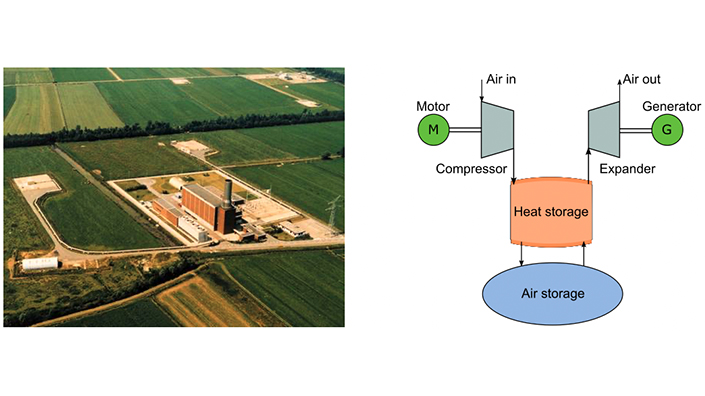
A view of the Huntorf CAES plant, built in Germany in 1978, and a schematic layout of a CAES system with heat storage
Pumped-thermal electricity storage
PTES systems, also referred to as pumped-heat energy/ electricity storage or Carnot batteries, convert excess electricity into thermal energy (heat and/ or cold), which is stored in vessels filled with liquid or solid thermal energy storage (TES) media such as water, oils, molten salts and gravel, amongst others. Large-scale TES has been used successfully, in concentrating solar power (CSP) plants for example, for many years.
When discharging, the stored thermal energy is used to drive a heat engine, which generates electricity by operating across the temperature difference between the hot and/ or cold stores when needed. PTES systems are typically being proposed based on classic Brayton or Rankine cycles, but many different configurations are possible.
PTES plants can employ standard components such as compressors, turbines and pumps, which reduces development time and resources. In some cases however, dedicated innovative components, in particular reciprocating machines, are under development for this specific application, as these promise improved performance.
The world’s first PTES demonstration plant is already in operation, and other concepts are receiving commercial interest.
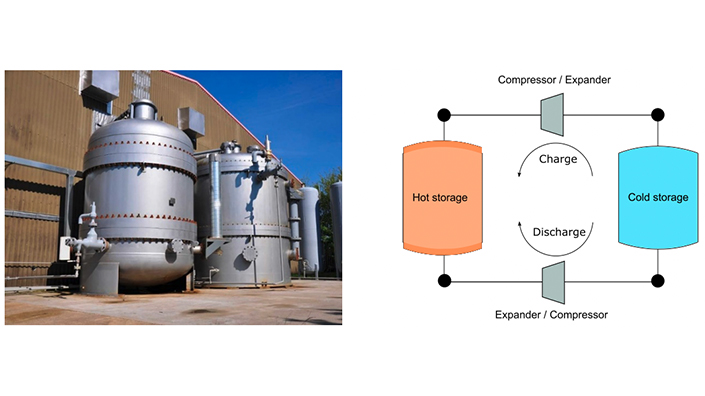
A PTES system demonstrator at Newcastle University, and a schematic layout of a PTES system showing the charging and discharging processes
Liquid-air energy storage
LAES is another promising TMES technology that combines elements of compressed air and pumped thermal. In this type of system, excess electricity is used to liquify air, which is then stored in cryogenic tanks at atmospheric pressure – meaning no expensive pressure-resistant storage is required.
When electricity is needed, the liquid air is discharged by first increasing its pressure in a pump, and then evaporating it before expanding it through a turbine. The integration of additional hot and cold stores can increase the efficiency of these systems, alleviating the lost heat of compression and the cold energy of evaporation during the charging process.
The concept has been successfully proven in pilot plants, and a larger facility is expected to start commercial operation near Manchester in 2022.
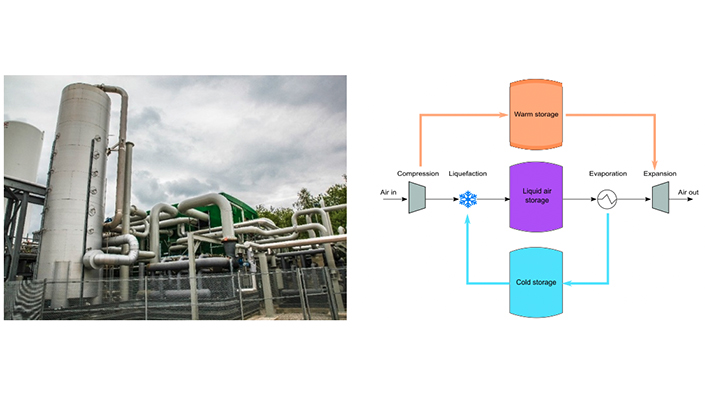
A LAES grid-scale demonstrator plant in Greater Manchester, and a schematic layout of a LAES system, showing the charging and discharging processes
The big question
Although the development of components and improved system configurations is a continuous process, these TMES technologies are based on proven concepts and have been successfully implemented at least at the pilot-plant scale or in larger demonstrator plants. TMES systems are capable of significantly larger power ratings (often >10 MW) and longer discharge durations (often >24 hours) than batteries.
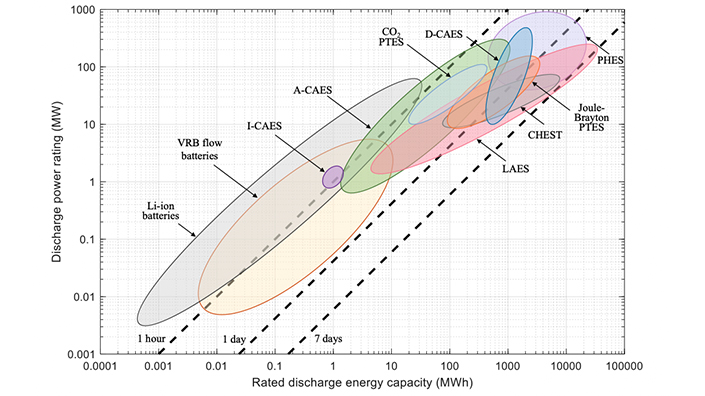
The discharge power rating and rated discharge energy capacity of selected large-scale electricity storage technologies
When underground caverns are available, CAES is projected to be the cheapest of the three TMES options, but it also has the lowest energy density because it requires a large volume to store the pressurised air. PTES and LAES systems are both capable of achieving higher energy densities because the energy is stored in liquid or solid materials, rather than a gas. Although their capital costs are likely to be higher than that of CAES, these technologies show promise, and are not restricted to sites with large available air storage volumes.
The achievable roundtrip efficiency of these TMES systems – defined as the ratio of the electricity recovered from discharging to the electricity used for charging – is similar. Although efforts are always focused on this key performance indicator, this is arguably not as important as cost. CAES with heat storage, PTES and LAES are expected to reach efficiencies of 60-70%, 50-75% and 45-70% respectively.
While batteries can achieve higher efficiencies (60-90%), TMES technologies benefit strongly from economies of scales, so often have lower projected costs – often below $100/kWh – for large plants.
They also have several other advantages, including significantly longer lifetimes (30 years or more), the ability to store energy for longer durations, the potential to be integrated with other external energy sources, such as waste heat or cold, the inherent capacity to contribute to grid stability by providing inertia, and the option to provide additional heating and/ or cooling alongside electricity.
A recent review article on the topic of TMES technologies shows that these are attractive, cost-competitive options for large-scale energy storage.
The authors acknowledge funding for this work from the UK Engineering and Physical Sciences Research Council as part of the Idles Programme.
To hear more on this topic, join the Energy Futures Lab online event on 8 March at 1pm: Beyond batteries and pumped hydro for large-scale energy storage.
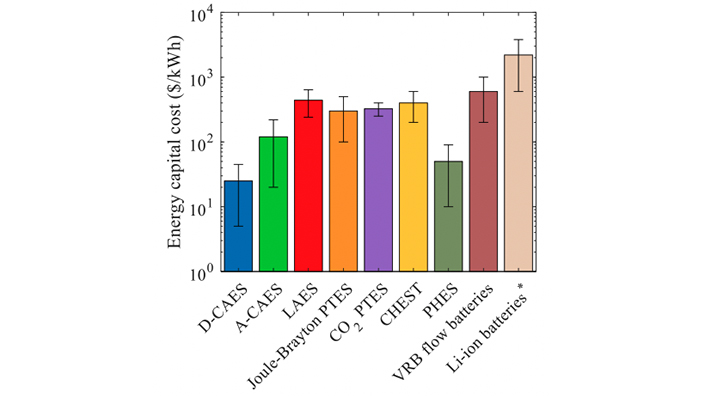
The energy capital cost of different types of TMES systems, PHES, vanadium redox (VRB) flow batteries and Li-ion batteries
Want the best engineering stories delivered straight to your inbox? The Professional Engineering newsletter gives you vital updates on the most cutting-edge engineering and exciting new job opportunities. To sign up, click here.
Content published by Professional Engineering does not necessarily represent the views of the Institution of Mechanical Engineers.